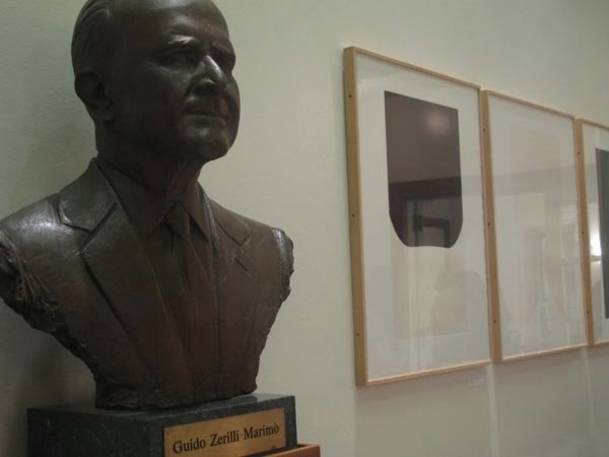


The both homely and institutional air that one could breathe at NYU's Casa Italiana made it possible for everyone to feel equally part of the event.
Alberto Burri (1915-1995), one of the main avant-garde painters and sculptors of Italy and Europe, created – between the 1940s and ‘90s – a large number of abstract works of art distinguished by innovative technical experimentations.
The exhibition is divided into two parts, one is on view at the Casa Italiana, while the other, which includes a smaller number of Burri’s graphic works in color, is hosted at the Italian Institute of Culture in New York [2]and was inaugurated on September 24.
All the works of art pertain to the artist’s graphic output dating from 1965 to 1994, one year before his death. Both parts of the exhibition will be on view until October 23, 2009.
Stefano Albertini, director of the Casa Italiana and Professor of Italian Studies at NYU, greeted the guests attending the opening together with Baroness Mariuccia Zerrilli-Marimò, founder of the Casa, Antonio Sapone, a representative of the “Fondazione Palazzo Albizzini Collezione Burri”, and Casa Italiana’s artistic adviser and promoter of the exhibition, Isabella Del Frate. The Burri museum, conceived by the artist, is in his hometown Città di Castello, Umbria.
Desplayed at the Casa’s main floor, this part of the exhibition consists of three kinds of graphic works: Combustions, Black and Whites and Cretti. This choice of graphic works underlines Alberto Burri’s artistic innovation. This period is quite different from the artist’s previous one, distinguished by the provocative use of materials such as plastic, wood, tar, jute, iron, etc.
The works on view at the Casa Italiana bring together not only the artist’s experimentation, but his approach to ‘risk’, as stated by Antonio Sapone (also a childhood friend of Burri’s) through the use of lithography, etching and aquatint.
Burri’s graphic production is not well known to the public and Antonio Sapone explained that the Foundation wants to promote it starting from New York. Sapone also explained that the artist was very rigorous in the way he created his works of art and that he always pursued innovation.
Burri’s “gamble”, as Sapone defined it, consists in the creation of compositions, first carefully studied and drawn, controlling the combustion to obtain the original project. It’s a gamble because it challenges the natural force of the elements: blowing against a flame.
Burri used the same process for his Cretti. He would use a synthetic material that would become fluid when heated and expand naturally into the platform he had previously prepared.
Sapone, being close to the artist, was witness of his efforts to achieve the results desidered.
From risk to rigorous study and practice, Alberto Burri (who had been a prisoner of war in Texas during World War II, where he had begun to paint) seems to enclose every aspect of reality in his artistic production.
(Translated by Julian Sachs)
Source URL: http://test.casaitaliananyu.org/magazine/focus/art-culture/article/alberto-burri-combustions-black-and-whites-and-cretti-casa
Links
[1] http://test.casaitaliananyu.org/files/11323burrimarimo1254785090jpg
[2] http://www.iicnewyork.esteri.it/IIC_Newyork